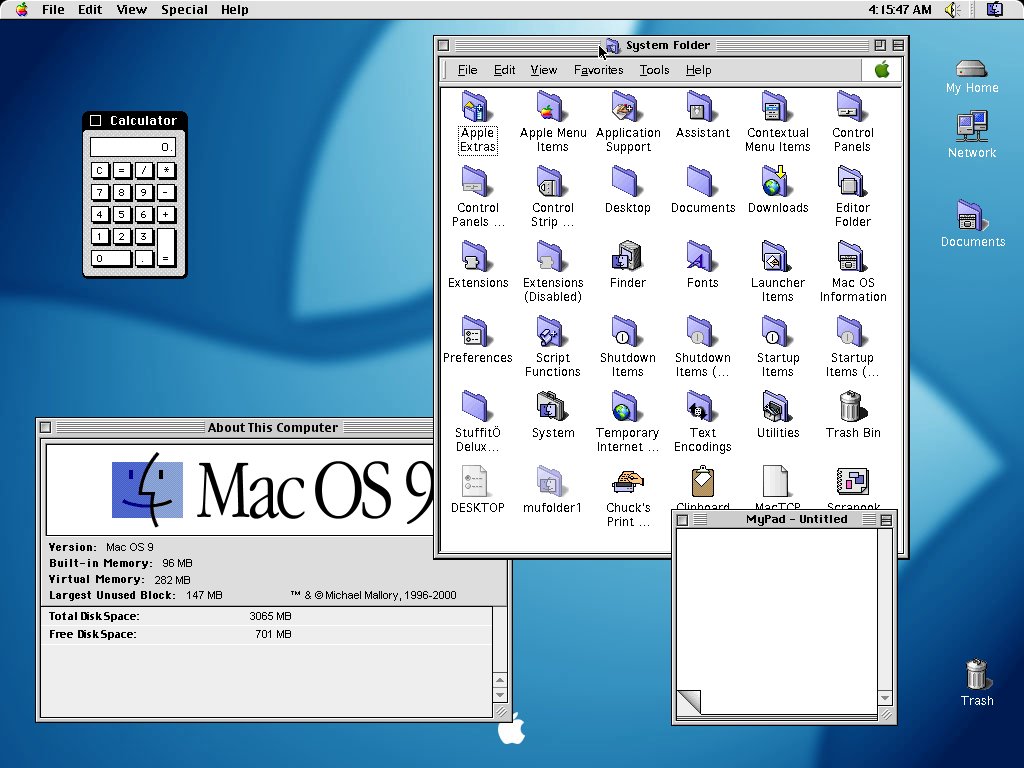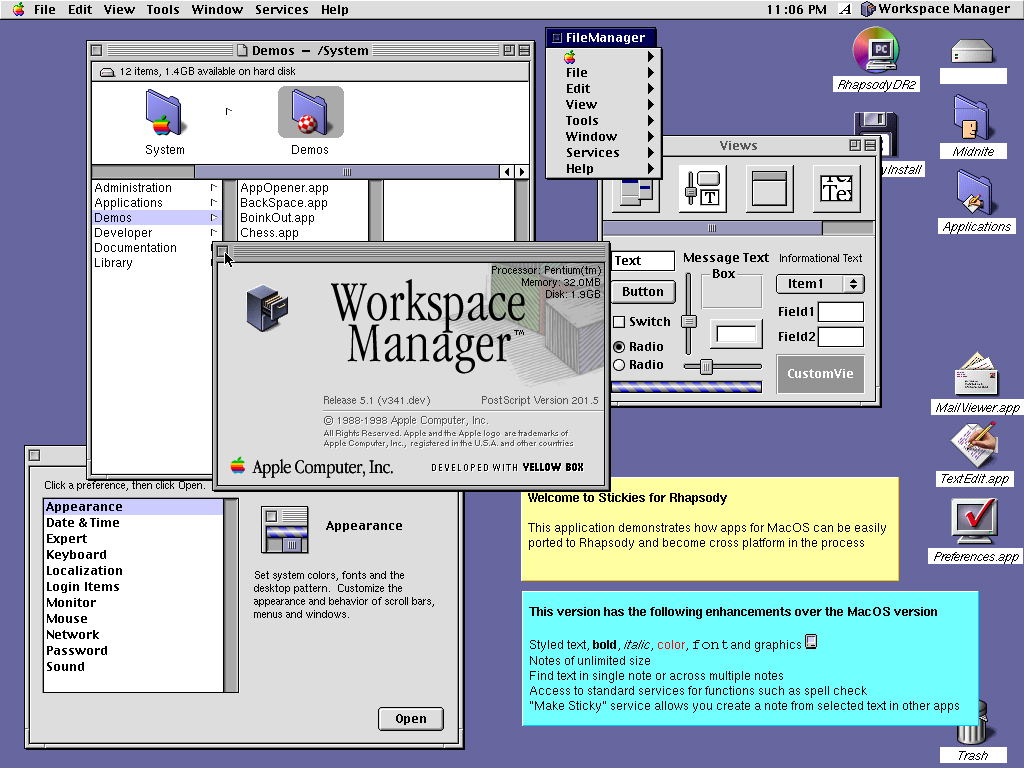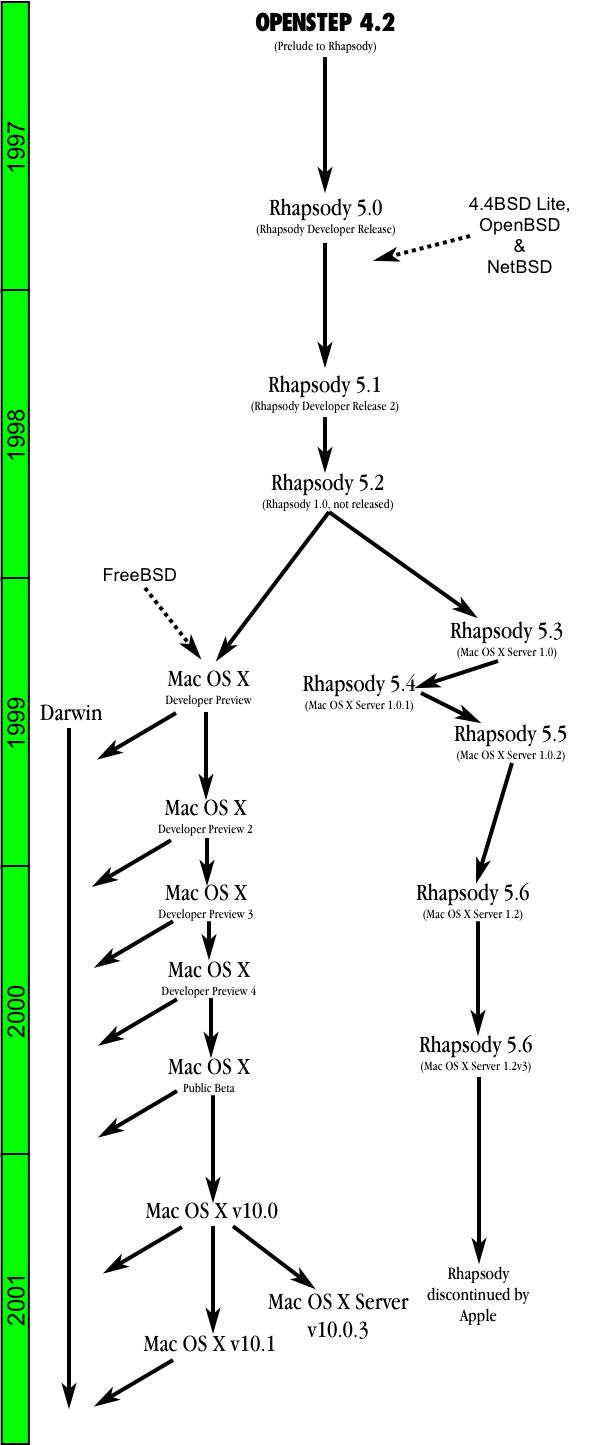History of Apple operating systems. Part 4. New time
The first part: habrahabr.ru/post/194696
The second part: habrahabr.ru/post/196276
The third part: habrahabr.ru/post/197160
Today I complete this cycle of translations. The fourth part will be about the latest versions of Mac OS Classic, the beginning of Mac OS X and a little bit about non-computer products from Apple.
The next release after the purchase of NeXT received the number 7.6. Mac OS 8.0 was first wanted to be released as 7.7, but then they changed their mind and did it as it is.

This includes some new items originally planned for Copland. For example:
In Mac OS 8 there was a multi-threaded Finder, which finally allowed to perform several operations on files simultaneously. There was also a context menu with ctrl-click access, personal web hosting, and much better support for power saving, USB and FireWire. For work on the Internet both IE and Netscape were delivered simultaneously. Java was supported through the Macintosh Runtime for Java (MRJ) runtime, which was also bundled. Version 8.1 was the last for 68k, starting from 8.5 only PowerPC processors were supported. In version 8.6, the microkernel was rewritten again to improve support for multitasking and multiprocessing. A memory allocator suitable for preemptive multitasking has appeared. API multiprocessing library has ceased to conflict with virtual memory.
')
Mac OS 9 is coming out in 1999. The advertisement claimed that this is the best operating system for the Internet. At least, she was able to update on the network. Improved cryptography and security features, support for AppleTalk over TCP / IP.

Mac OS 9 includes a stable version of the API Carbon. It included 70% of the API of old Mac OS versions and ensured full compatibility with newer versions of Mac OS 8.1. The latest release of Mac OS Classic, 9.2.2, was released in late 2001.

Rhapsody was first shown to the public at the WWDC in 1997. It appeared as a continuation of OPENSTEP with the addition of compatibility with Mac OS. Significant components:
Rhapsody planned to port many components of Mac OS: QuickTime, QuickDraw 3D, QuickDraw GX, ColorSync, etc. Many file systems were supported: Apple Filing Protocol (AFP), FAT, HFS, HFS +, ISO9660, and UFS.
There are two releases of Rhapsody - DR1 and DR2, both for developers. They supported the PowerPC and x86 platforms.
For compatibility with the PowerPC version of the DR1 with Mac OS, the

Yellow Box is a platform for developing Rhapsody, designed as an add-on system or as an application for Windows.
Many libraries from OPENSTEP, runtime for all of this, and development tools have been included in the Yellow Box. For the three most important components were APIs on Objective-C and Java:
The Yellow Box included the IDE Project Builder and the visual Interface Builder tool for what. Yellow Box under Windows NT was about the same in functionality. Low-level services working with hardware were rewritten as Windows services. For example, this is the Mach
After the release of Rhapsody DR2, Apple once again radically changes its OS release strategy. The release of a fundamentally new system will take three years. The figure shows an approximate scheme of evolution:

Instead of the expected public Rhapsody DR3 in March 1999, Apple suddenly releases Mac OS X Server 1.0. In general, this system can be considered the next version of Rhapsody. Included was a WebObjects framework, a QuickTime stream server, Apache, development tools, and remote administration.
Parallel to this, the first version of Apple Darwin, the open source Rhapsody fork, comes out.
The next couple of years will be released updates server version, which immediately integrated into the not yet released user version. In the future, they will not have global differences.
It was released 4 versions of Mac OS X Developer Preview, they were called DP1-4. New features were gradually added to them:

A paid beta worth $ 29.95 was released in September 2000. Apple's message tohamsters beta testers was on the cover - “Hold on to the future of the Macintosh”
It is clear that the beta lacked neither stability nor functionality. But it was an exciting demonstration of Apple's ambution and technology. To the general public for the first time, a
The core of Darwin is called
Mac OS X 10.0 was released on March 24, 2001. Soon, the Mac OS X Server numbering scheme was adapted to the desktop versions. After that, they began to go out in pairs, but the desktop a little earlier.
At the time of publication of the article were such versions:
All versions ( up to 10.9, published in 2013 - approx. Transl. ) Were called the names of big cats. ( Cheetah is a cheetah. Ironically, 10.0 worked very slowly - approx. Transl. )
In version 10.0, iMovie and iTunes appeared, in 10.1 iDVD was added. The carbon API led to a stable version also in 10.1. This allowed us to quickly release a lot of important software, such as Photoshop.
In 10.2 added a lot of important improvements. The most notable of them is Quartz Extreme, a hardware acceleration engine for interface rendering. In addition, many new programs have been added: Address Book, Mail, Chat, Rendezvous for networking, iPhoto, Safari, X-server and much more.
In 10.3, stability and security are generally improved.
After that, the system as a whole became similar to what Apple had planned. New users bought Macs and immediately began to work efficiently, the old ones did not run up in a panic from the unfamiliar arrangement of buttons and menus. Well, in general, among Apple supporters there are many people of different professions, inclinationsand orientations.
A description of the internal structure of Mac OS X can be found in the book of the author of the original Mac OS X Internals article.
In addition to computers and servers, Apple released all sorts of other intelligent devices.
Pippin is a multimedia device, set-top box or network computer originally from the mid-90s. Whoever wants, calls. It was possible to listen to an audio CD, surf the Internet, read emails and play games, but you cannot use it as a full-fledged computer. That is, this device with artificially limited features like a game console. It was planned to sell the license to third-party manufacturers. In fact, it was PowerMac with limitations. It is based on a 66 MHz PowerPC 603e processor, contains 6 MB of memory, 128 KB flash, 4x CD-ROM, stereo sound, several video outputs, a PCI expansion slot, ADB connectors for a keyboard and a mouse, a modem, a keyboard and a gamepad. For all this, a special version of Mac OS was used. The project was born dead and was not successful. The name comes from the same varieties of apples.
Apple had a line of tablet-like devices Newton. Basically, they belonged to the MessagePad line. A rare exception is the eMate 300. There were clones. The very first MessagePad worked on a 20 MHz ARM 610 processor, all sufficed for its 640 KB of RAM and 4 MB of ROM. It was 1993, the version of the software Newton OS 1.0. The era ended in 1998. The latest model MP2100 had a StrongARM processor with a frequency of 162 MHz and 8 MB of RAM and ROM each. OS version numbering has reached Newton OS 2.1.
Newton System Software is quite logical divided into the core of Newton OS, system services and custom components. In general, it was a fairly advanced OS with preemptive multitasking. All internal mechanics like the scheduler, task management, interprocess communication, memory management, power, and work with iron were implemented through kernel threads. There was a very advanced subsystem of working with serial protocols. In those years, it allowed the use of faxes, modems, infrared devices, AppleTalk networks. You could even add new protocols on the fly.
In the topmost layer, NewtonScript and user interface programs worked. All user applications, both embedded and installed separately, were executed as one OS task.
Feature Newton - non-modal interface with handwriting recognition, text, shapes and gestures. Printed letters, handwritten letters, and their mixtures were maintained. The shapes of the figures could also be very different. Some successor to this technology is included in Mac OS X called Inkwell.
IPods quickly became very popular. They work on a proprietary OS.
In the first iPods of the year 2001, the “About” tab mentioned PortalPlayer. This is a company that licenses music software for computers, music players and consumer electronics. We also used the practices of the company Pixo. They specialize in the development of mobile phone firmware.
The iPod uses the Digital Media Platform developed by PortalPlayer. This is a complex of hardware and extensible software, programs for synchronization with a computer, third-party extensions and other things. A PP50xx chip with two ARM7TDMI cores was used.
Pixo provided a tool for developing the user interface, and drew it directly to Apple. They own many libraries and built-in applications like address book.
The second part: habrahabr.ru/post/196276
The third part: habrahabr.ru/post/197160
Today I complete this cycle of translations. The fourth part will be about the latest versions of Mac OS Classic, the beginning of Mac OS X and a little bit about non-computer products from Apple.
Mature Mac OS
The next release after the purchase of NeXT received the number 7.6. Mac OS 8.0 was first wanted to be released as 7.7, but then they changed their mind and did it as it is.
Mac OS 8

This includes some new items originally planned for Copland. For example:
- HFS + File System
- Search engine for local drives, network servers and the Internet. Known as Sherlock.
- API Copland, which then smoothly mutated into Carbon - the old developers under Mac OS let out a mean tear.
- Platinum interface theme, see screenshot
- Multiple user support with minimal decent access restriction
In Mac OS 8 there was a multi-threaded Finder, which finally allowed to perform several operations on files simultaneously. There was also a context menu with ctrl-click access, personal web hosting, and much better support for power saving, USB and FireWire. For work on the Internet both IE and Netscape were delivered simultaneously. Java was supported through the Macintosh Runtime for Java (MRJ) runtime, which was also bundled. Version 8.1 was the last for 68k, starting from 8.5 only PowerPC processors were supported. In version 8.6, the microkernel was rewritten again to improve support for multitasking and multiprocessing. A memory allocator suitable for preemptive multitasking has appeared. API multiprocessing library has ceased to conflict with virtual memory.
')
Mac OS 9
Mac OS 9 is coming out in 1999. The advertisement claimed that this is the best operating system for the Internet. At least, she was able to update on the network. Improved cryptography and security features, support for AppleTalk over TCP / IP.

Mac OS 9 includes a stable version of the API Carbon. It included 70% of the API of old Mac OS versions and ensured full compatibility with newer versions of Mac OS 8.1. The latest release of Mac OS Classic, 9.2.2, was released in late 2001.
Rhapsody

Rhapsody was first shown to the public at the WWDC in 1997. It appeared as a continuation of OPENSTEP with the addition of compatibility with Mac OS. Significant components:
- Kernel and its subsystems based on Mach and BSD
- Further development of the OpenStep API, codename Yellow Box
- Java virtual machine
- Mac OS compatibility layer called Blue Box
- Mac OS-like interface theme for OPENSTEP
Rhapsody planned to port many components of Mac OS: QuickTime, QuickDraw 3D, QuickDraw GX, ColorSync, etc. Many file systems were supported: Apple Filing Protocol (AFP), FAT, HFS, HFS +, ISO9660, and UFS.
There are two releases of Rhapsody - DR1 and DR2, both for developers. They supported the PowerPC and x86 platforms.
Blue box
For compatibility with the PowerPC version of the DR1 with Mac OS, the
MacOS.app application was MacOS.app , it is the Blue Box. This is a virtual environment without hardware emulation, only Macintosh ROM calls are broadcast, which are sent to a slightly modified copy of Mac OS running from disk. Initially 'emulated Mac OS 8.x in full-screen application mode, with the ability to switch back to Rhapsody. Not supported programs that work with iron directly and use dirty hacks. Support for newer versions of Mac OS and interface improvements added over time.Yellow box

Yellow Box is a platform for developing Rhapsody, designed as an add-on system or as an application for Windows.
Many libraries from OPENSTEP, runtime for all of this, and development tools have been included in the Yellow Box. For the three most important components were APIs on Objective-C and Java:
- Foundation: base classes for the allocation, release, validation, storage, notification, and distribution of objects.
- Application Kit: rich API for creating user interface. Receiving and processing of events, working with color, fonts, printers and other custom pieces.
- Display PostScript: API for working with PostScript, image overlay and all sorts of visual effects. In general, this is part of the Application Kit.
The Yellow Box included the IDE Project Builder and the visual Interface Builder tool for what. Yellow Box under Windows NT was about the same in functionality. Low-level services working with hardware were rewritten as Windows services. For example, this is the Mach
machd kernel emulator and the nmserver name nmserver . Everything else was user programs, like WindowServer and pbs , the clipboard server. Similar architecture was also available for early implementations of OpenStep for third-party OS, for example, Solaris.On the near approaches to Mac OS X
After the release of Rhapsody DR2, Apple once again radically changes its OS release strategy. The release of a fundamentally new system will take three years. The figure shows an approximate scheme of evolution:

Mac OS X Server 1.x
Instead of the expected public Rhapsody DR3 in March 1999, Apple suddenly releases Mac OS X Server 1.0. In general, this system can be considered the next version of Rhapsody. Included was a WebObjects framework, a QuickTime stream server, Apache, development tools, and remote administration.
Parallel to this, the first version of Apple Darwin, the open source Rhapsody fork, comes out.
The next couple of years will be released updates server version, which immediately integrated into the not yet released user version. In the future, they will not have global differences.
Mac OS X Developer Preview
It was released 4 versions of Mac OS X Developer Preview, they were called DP1-4. New features were gradually added to them:
- Implemented API Carbon (DP1), to run old, but recompiled applications in the new OS. This softened the urgency of the transition to a fundamentally new system. The old application required Mac OS 9 to run, and Carbon applications would run without it. Carbon was called the old API, as opposed to the new Cocoa. At the same time, they had some small degree of compatibility.
- Blue Box app,
MacOS.app, renamed toClassic.app(DP2) - Yellow Box renamed Cocoa, added Java support to it (DP2)
- Aqua Interface (DP3)
Mac OS X Public Beta

A paid beta worth $ 29.95 was released in September 2000. Apple's message to
It is clear that the beta lacked neither stability nor functionality. But it was an exciting demonstration of Apple's ambution and technology. To the general public for the first time, a
xnu inherently Darwin with the xnu kernel, a PDF-based graphics system Quartz, an Aqua interface with their proprietary dock, and so on, was shown. Darwin allowed to borrow and integrate a significant amount of third-party open source software and the corresponding license into Mac OS X.The core of Darwin is called
xnu . One of the decryption options is “X is Not Unix”. Or is it a hint of their old NuKernel kernel, reworked for Mac OS X. xnu contains the code for Mach, FreeBSD, MkLinux and heaps of other sources.Mac OS X 10.x
Mac OS X 10.0 was released on March 24, 2001. Soon, the Mac OS X Server numbering scheme was adapted to the desktop versions. After that, they began to go out in pairs, but the desktop a little earlier.
At the time of publication of the article were such versions:
| 10.0 | Cheetah | March 24, 2001 |
| 10.1 | Puma | September 29, 2001 |
| 10.2 | Jaguar | August 24, 2002 |
| 10.3 | Panther | October 24, 2003 |
All versions ( up to 10.9, published in 2013 - approx. Transl. ) Were called the names of big cats. ( Cheetah is a cheetah. Ironically, 10.0 worked very slowly - approx. Transl. )
In version 10.0, iMovie and iTunes appeared, in 10.1 iDVD was added. The carbon API led to a stable version also in 10.1. This allowed us to quickly release a lot of important software, such as Photoshop.
In 10.2 added a lot of important improvements. The most notable of them is Quartz Extreme, a hardware acceleration engine for interface rendering. In addition, many new programs have been added: Address Book, Mail, Chat, Rendezvous for networking, iPhoto, Safari, X-server and much more.
In 10.3, stability and security are generally improved.
After that, the system as a whole became similar to what Apple had planned. New users bought Macs and immediately began to work efficiently, the old ones did not run up in a panic from the unfamiliar arrangement of buttons and menus. Well, in general, among Apple supporters there are many people of different professions, inclinations
A description of the internal structure of Mac OS X can be found in the book of the author of the original Mac OS X Internals article.
miscellanea
In addition to computers and servers, Apple released all sorts of other intelligent devices.
Pippin
Pippin is a multimedia device, set-top box or network computer originally from the mid-90s. Whoever wants, calls. It was possible to listen to an audio CD, surf the Internet, read emails and play games, but you cannot use it as a full-fledged computer. That is, this device with artificially limited features like a game console. It was planned to sell the license to third-party manufacturers. In fact, it was PowerMac with limitations. It is based on a 66 MHz PowerPC 603e processor, contains 6 MB of memory, 128 KB flash, 4x CD-ROM, stereo sound, several video outputs, a PCI expansion slot, ADB connectors for a keyboard and a mouse, a modem, a keyboard and a gamepad. For all this, a special version of Mac OS was used. The project was born dead and was not successful. The name comes from the same varieties of apples.
Newton
Apple had a line of tablet-like devices Newton. Basically, they belonged to the MessagePad line. A rare exception is the eMate 300. There were clones. The very first MessagePad worked on a 20 MHz ARM 610 processor, all sufficed for its 640 KB of RAM and 4 MB of ROM. It was 1993, the version of the software Newton OS 1.0. The era ended in 1998. The latest model MP2100 had a StrongARM processor with a frequency of 162 MHz and 8 MB of RAM and ROM each. OS version numbering has reached Newton OS 2.1.
Newton System Software is quite logical divided into the core of Newton OS, system services and custom components. In general, it was a fairly advanced OS with preemptive multitasking. All internal mechanics like the scheduler, task management, interprocess communication, memory management, power, and work with iron were implemented through kernel threads. There was a very advanced subsystem of working with serial protocols. In those years, it allowed the use of faxes, modems, infrared devices, AppleTalk networks. You could even add new protocols on the fly.
In the topmost layer, NewtonScript and user interface programs worked. All user applications, both embedded and installed separately, were executed as one OS task.
Feature Newton - non-modal interface with handwriting recognition, text, shapes and gestures. Printed letters, handwritten letters, and their mixtures were maintained. The shapes of the figures could also be very different. Some successor to this technology is included in Mac OS X called Inkwell.
iPod
IPods quickly became very popular. They work on a proprietary OS.
In the first iPods of the year 2001, the “About” tab mentioned PortalPlayer. This is a company that licenses music software for computers, music players and consumer electronics. We also used the practices of the company Pixo. They specialize in the development of mobile phone firmware.
The iPod uses the Digital Media Platform developed by PortalPlayer. This is a complex of hardware and extensible software, programs for synchronization with a computer, third-party extensions and other things. A PP50xx chip with two ARM7TDMI cores was used.
Pixo provided a tool for developing the user interface, and drew it directly to Apple. They own many libraries and built-in applications like address book.
iphone
Hidden text
Article 2004, then iPhones were not yet

Article 2004, then iPhones were not yet
Source: https://habr.com/ru/post/198016/
All Articles